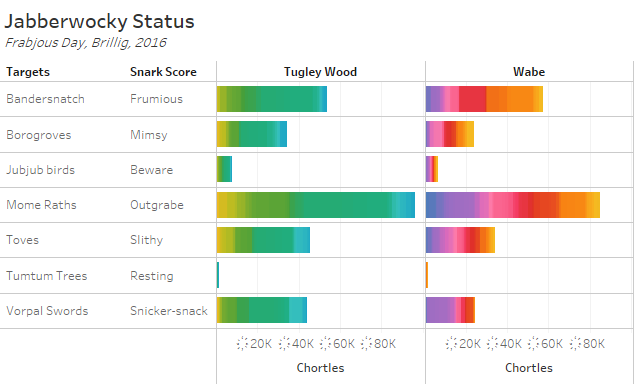Mastering a craft is not the same as mastering a tool. Recently, I was re-named a Tableau Zen Master, but sometimes I mentally strike the word “Tableau.” The software is my tool. Data is my craft. The path to mastering anything is common to almost any skill. It takes ever-expanding knowledge put into focused practice. This post is about the path I’ve traveled.
Learning as You Go Has Its Limits
I used to learn new things by using it here and there to solve immediate problems. I’d poke around Google, user forums and how-to videos to find the steps I’d need. That works to learn something quickly, but it isn’t the best way to learn it deeply. On-the-job training will always be limited by the tasks you encounter in your specialty.
As an engineer, I handled project financials, sensor data and maintenance records. As soon as I stepped into consulting, I encountered a wider range of data on things like health care, human resources, marketing, surveys, call centers, retail, education, telecom and manufacturing. Constant reading fills in gaps where I don’t have direct experience.
Lately, I’ve grown to take a more systematic approach. Formal Tableau training showed me things I never encountered in the years I had been using it. That helped me see how structured learning helps us build the whole picture, not just look at one interesting vignette at a time. I suggest a three-part process:
- Learn the language that’s peculiar to your field
- Connect the concepts
- Apply those while presenting your work
Here, I’ll show how that relates to my field of visual analytics.
Step 1: Learn the Language
Writers must have a strong grasp of their language. The same is true for terminology in some specialty. In visual language, poor chart construction is like writing an essay with bad grammar. You may get the point across, but readers will be confused or question your expertise. That’s why the so-called “rules” of data visualization are important. Language rules have many exceptions, but those come long after you can construct a basic sentence.
We should know how readers interpret visual encodings just like authors know how we define words in various contexts. Bar length is read as proportional to the value it represents, which is why you shouldn’t truncate the axis. Lines imply connectedness, so don’t use them with disconnected categories. Pie charts are split into parts of a whole, so they shouldn’t add up to anything other than 100%.
These things are elementary to many of us, but that’s where learning starts. Every large company has at least one analyst who has yet to hear the foundational concepts above. We can’t skip that step, nor can we stop there. For example, I had no idea what a Marimekko chart was until Tableau announced the capability in version 10. If that’s you right now, take the time to read Jonathan Drummey’s post on it and keep that knowledge for later.
Step 2: Connect the Concepts
It’s one thing to turn words into sentences or numbers into charts. It’s quite another to convey meaning through those activities. “The cow jumped over the moon” is grammatically correct but complete nonsense because cows can’t do that. Ditto for a chart comparing margarine consumption and Maine’s divorce rate. Tyler Vigen’s popular page, Spurious Correlations, has this and other silly examples that illustrate errors in critical thinking that happen every day.
It’s easier to spot reasoning errors in others than in ourselves. Do you know how to test cause-effect relationships? Can you avoid logical fallacies or cognitive biases? Mature experts have the courage and humility to ask others (often outside their specialty) to spot holes in their argument. This is where reading outside of your field or personal perspective is especially helpful.
Discovering logical connections and reducing a range of interpretations down to a supportable conclusion is the difference between communicating insight and making a dashboard that reads like a stanza from Jabberwocky.

Your audience reacts to illogical dashboards the same way Alice did to the poem in Lewis Carroll’s book, “Through the Looking-Glass and What Alice Found There:”
“It seems very pretty,” she said when she had finished it, “but it’s rather hard to understand!” (You see she didn’t like to confess, even to herself, that she couldn’t make it out at all.) “Somehow it seems to fill my head with ideas—only I don’t exactly know what they are! However, somebody killed something: that’s clear, at any rate.”
You may have made an impressive display, but the numbers just don’t belong together. It looks attractive but lacks a clear sense or idea. Just like we can’t skip learning the meaning of visual encodings, we can’t skip the process of extracting meaning from the numbers.
Step 3: Storytelling
If you’ve scanned subheadings and landed here on the “exciting” part, scroll back up. Honing your skills involves taking the time to care about the mundane practice necessary to do the fun part well. No one plays Mozart until they’ve mastered the scales. Where I see data stories fail is the lack of attention to optimal visualization types or too little time critically analyzing data. I see that in my own work as I look back and find what could have been better.
Starting with storytelling leads to one of the most common errors we face: the narrative fallacy. We are hardwired to weave facts into patterns and stories. This desire makes us believe in connections that don’t exist. It causes us to ignore facts that don’t fit neatly into that story. However, where there is a real story, it helps us cement that conclusion in our memories.
We should all want to master the art of storytelling to convey ideas. With that, we must first seek the truth of the matter and be confident in our conclusion before telling it. If you want to be better at this task, spend a lot more time practicing foundational concepts and how they work together. The stories will naturally flow from there.
Always Be Learning
These three phases of mastering a craft parallel the ancient Greek arts of grammar, logic (or dialectic) and rhetoric – later known together as the Trivium. This framework has taken me farther, faster than my old ways of learning solutions as problems arise. I’ve shared how this looks in my field, but similar things work in almost any discipline. Whatever your approach, the key is to keep going after new knowledge, seek to understand it and apply it with wisdom.
This is my story. Yours will be different. I’d love to hear about your experiences, so find me on Twitter (@bibleviz) or comment below.


